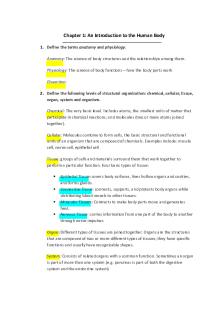Chapter 1 Study Guide - Dr. Alan Huebner PDF

| Title | Chapter 1 Study Guide - Dr. Alan Huebner |
|---|---|
| Course | Statistical Methods & Data Analysis |
| Institution | University of Notre Dame |
| Pages | 2 |
| File Size | 138.4 KB |
| File Type | |
| Total Downloads | 90 |
| Total Views | 139 |
Summary
Dr. Alan Huebner...
Description
Chapter 1 Study Guide Practice Problems: • •
From the text (answers are provided in the back of the book): 1.37, 1.45, 1.49 (the data can be quickly typed into R), 1.57 (parts a and c), 1.61, 1.65, 1.71 Also, Example 1.10, Example 1.17
Chapter 1 Learning Objectives: • • • • • • • • • • • •
Given a written problem, identify the population, sample, experimental units, and variables Distinguish between population parameters and sample estimates. Calculate the sample variance and sd “by hand” Calculate a confidence interval for any confidence level and interpret it in the context of the problem. Given a written problem, identify the null and alternative hypotheses. Given a written problem, identify the type of test to perform (e.g. single mean or two means, large or small sample, paired, lower, upper or two-tailed, etc.) Given sample statistics, perform all steps of a hypothesis test. Recite the definition of a p-value on page 43 of the text and apply it in a given context. Explain Type I and Type II error in the context of a specific hypothesis test. Write R code to obtain critical values and p-values, i.e. know how to use pnorm() and qnorm() Identify the inputs and outputs of the following R functions: library(), hist(), mean(), sd(), var(). Know how to access columns of an R data frame using the $ symbol. Identify the output when brackets [ ] are applied to a vector in R (this is known as “subsetting”).
Notes: •
The text presents two methods of performing a hypothesis test, (1) the p-value approach and (2) the critical value approach. We will only do (1), so anything about (2) can be ignored.
Chapter 3 Study Guide Chapter 3 Learning Objectives: Objectives for Exam 1: •
• • •
• •
• • • • •
Write down the linear regression model and identify all components (intercept, slope, error, predictor and response variable), sketch an / axis with these quantities labeled, and give conceptual explanations of each. 1 , and specific values of and . Give Compute fitted values (�s) and residuals (s) given 0 , conceptual explanations of the �s and s, and sketch an / axis with these quantities labeled. Explain the concept of “least squares”, i.e. the linear regression line minimizes the sum of squared errors (SSE). Given a small data set (i.e and �s) compute the SSE and , and interpret is the context of a given problem.
Note: The objectives below will NOT be included on Exam 1 Compute and interpret a CI for 1 . Use the qt() function to obtain the critical value for the CI. Perform a hypothesis test for 1 . Calculate the test statistic given 1 and �1 . Use the pt() function in R to compute the p-value. State the conclusion of the test, and give a conceptual explanation of the p-value. Explain the summary output for the lm() function in R including the columns Estimate, Std. Error, t value and Pr(>|z|). Explain the relation between a CI and test for 1 . Describe the concept of correlation between two variables. Perform a hypothesis test for a correlation. Interpret the coefficient of determination 2 and explain the concept via a sketch with the quantities and labeled....
Similar Free PDFs

Chapter 1: Study Guide
- 3 Pages

Chapter 1 Study Guide
- 1 Pages

Chapter 1 - study guide
- 15 Pages

Chapter 1: study Guide
- 4 Pages

Chapter 1 Study Guide
- 11 Pages

Chapter 1 Study Guide
- 7 Pages

Chapter 1 Study Guide
- 4 Pages

Exam 1 Study Guide - Dr. Staffel
- 3 Pages

EXAM 1 Study Guide - Dr. Baird
- 9 Pages

Exam 1 Study Guide - Dr. Stotzpotter
- 25 Pages

Acct Chapter 1 Study Guide
- 8 Pages

Chapter 1 Study Guide MKT
- 22 Pages

Chapter 1 Study Guide Answers
- 12 Pages

Chapter 1 Study Guide Answers
- 4 Pages
Popular Institutions
- Tinajero National High School - Annex
- Politeknik Caltex Riau
- Yokohama City University
- SGT University
- University of Al-Qadisiyah
- Divine Word College of Vigan
- Techniek College Rotterdam
- Universidade de Santiago
- Universiti Teknologi MARA Cawangan Johor Kampus Pasir Gudang
- Poltekkes Kemenkes Yogyakarta
- Baguio City National High School
- Colegio san marcos
- preparatoria uno
- Centro de Bachillerato Tecnológico Industrial y de Servicios No. 107
- Dalian Maritime University
- Quang Trung Secondary School
- Colegio Tecnológico en Informática
- Corporación Regional de Educación Superior
- Grupo CEDVA
- Dar Al Uloom University
- Centro de Estudios Preuniversitarios de la Universidad Nacional de Ingeniería
- 上智大学
- Aakash International School, Nuna Majara
- San Felipe Neri Catholic School
- Kang Chiao International School - New Taipei City
- Misamis Occidental National High School
- Institución Educativa Escuela Normal Juan Ladrilleros
- Kolehiyo ng Pantukan
- Batanes State College
- Instituto Continental
- Sekolah Menengah Kejuruan Kesehatan Kaltara (Tarakan)
- Colegio de La Inmaculada Concepcion - Cebu

